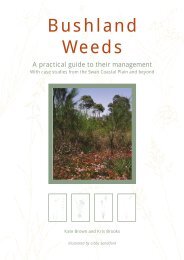Control And Management - Environmental Weeds Action Network
Control And Management - Environmental Weeds Action Network
Control And Management - Environmental Weeds Action Network
You also want an ePaper? Increase the reach of your titles
YUMPU automatically turns print PDFs into web optimized ePapers that Google loves.
Physical <strong>Control</strong>: Grubbing of plants is only practical for<br />
small infestations in very disturbed areas or on soil dumps.<br />
Dig out the whole plant early in the season before bulbil<br />
formation, sifting soil to remove as many of the bulbs as<br />
possible. Due to the numerous small bulbils, this can be a very<br />
tedious task. Plant material should be taken from the site and<br />
disposed of carefully. Leave bulbs and plant material to rot in<br />
plastic bags placed in the sun. Soil disturbance resulting from<br />
the grubbing of plants will encourage other weeds to colonise<br />
the area and may spread the Oxalis species.<br />
In heavily degraded areas heavy mulching may temporarily<br />
suppress oxalis. Cover area with weed matting or mulch over<br />
cardboard for the entire growing season. This method may be<br />
more successful on O. purpurea as research suggests that<br />
defoliation of this species reduces bulb development.<br />
<strong>Management</strong> Guidelines:<br />
· Mapping in mid winter is suggested - the bright<br />
flowers being highly visible.<br />
· Decide where resources should be best spent -<br />
control isolated clumps in healthy bushland first.<br />
· Timing of herbicide application is important spray<br />
just on flowering at time of maximum bulb<br />
exhaustion but before bulbils begin to develop.<br />
Spraying after flowering will not kill the bulbs so<br />
there is no point.<br />
· If hand grubbing, soil must be sifted to get as<br />
many bulbils as possible (only recommended for<br />
small populations in very disturbed areas or soil<br />
dumps)<br />
· Removal and careful disposal of all plant material<br />
is important - bulbils and pieces of rhizome can<br />
spread the weed! (it is important not to waste<br />
effort by removing plants ineffectively).<br />
· Follow up control in following years - map each<br />
year to check progress of control efforts and/or<br />
spread.<br />
NOTE: Cleaning mud containing bulbils from tools,<br />
boots and vehicles is important in restricting spread.<br />
References and further information:<br />
Du Plessis, N. and Duncan, G. (1989) Bulbous plants of southern Africa: A guide<br />
to their cultivation and propagation. Tafelberg Publishers: Cape Town.<br />
Hnatiuk, R.J. (1990) Census of Australian Vascular Plants. Australian Flora and<br />
Fauna Series N°11. Bureau of Flora and Fauna: Canberra.<br />
Hussey, B.M.J., Keighery, G.J., Cousens, R.D., Dodd, J. and Lloyd, S.G. (1997)<br />
Western <strong>Weeds</strong>: a guide to the weeds of Western Australia. The Plant Protection<br />
Society of Western Australia: Victoria Park.<br />
Parsons, W.T. and Cuthbertson, E.G. (1992) Noxious <strong>Weeds</strong> of Australia. Inkata<br />
Press: Melbourne & Sydney.<br />
Peirce, J.R. (1990) Effect of herbicides on growth and bulb production of four<br />
o’clock (Oxalis purpurea L.) and soursob (Oxalis pes-caprae L.), Proceedings of<br />
the ninth Australian <strong>Weeds</strong> Conference, Adelaide, South Australia.<br />
Peirce, J. (1998) Declared Plant <strong>Control</strong> Handbook. 5 th Ed. Misc Pub. 4/98.<br />
Agriculture Western Australia (updated version online at http://<br />
www.agric.wa.gov.au/progserv/plants/weeds/weed_control/index.htm).<br />
Peirce, J.R. (1998) Oxalis pes-caprae L. In The biology of Australian weeds, Vol.<br />
2, Eds Panetta, F.D., Groves, R.H. and Shepherd, R.C.H. R.G. and F.J. Richardson:<br />
Meredith.<br />
Scheltema, M. and Harris, J. (1995) Managing Perth’s Bushlands: Perth’s<br />
bushlands and how to manage them. Greening Western Australia: Perth.<br />
Getting Involved - The <strong>Environmental</strong> <strong>Weeds</strong><br />
<strong>Action</strong> <strong>Network</strong>:<br />
The <strong>Environmental</strong> <strong>Weeds</strong> <strong>Action</strong> <strong>Network</strong> (EWAN) is a<br />
community initiative to tackle the problem of environmental<br />
weeds in bushland and waterways. It brings together community<br />
members in both urban and rural areas, bush regenerators, local<br />
government, weed scientists and ecologists to save our indigenous<br />
flora from the threat of weeds.<br />
The aims of EWAN include:<br />
· promoting an understanding of the threat of environmental<br />
weeds to our precious bushland<br />
· providing useful information about weed control in<br />
native vegetation and elsewhere convincing governments<br />
at all levels of the need for appropriate<br />
legislation and funding for weed control<br />
· researching methods of weed control<br />
· encouraging community participation<br />
Telephone (08) 9220 5311 or visit our web site at<br />
http://members.iinet.net.au/~ewan/<br />
Acknowledgements:<br />
Kate Brown, Project Officer, EWAN<br />
John Pierce, Senior Research Officer, AGWEST<br />
Rod Randall, Plant Profiler, AGWEST<br />
Written by Kris Brooks (EWAN) for the <strong>Environmental</strong> <strong>Weeds</strong> <strong>Action</strong><br />
<strong>Network</strong>, July 2001.<br />
MANAGING WEEDS IN BUSHLAND<br />
Oxalis pes-caprae<br />
Oxalis glabra<br />
Oxalis purpurea<br />
SOURSOB, FINGERLEAF<br />
& FOUR O’CLOCK<br />
Oxalis pes-capre, O. glabra & O. purpurea<br />
Oxalidaceae



